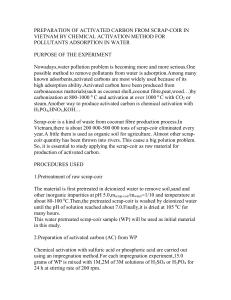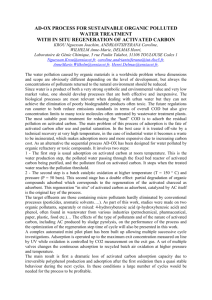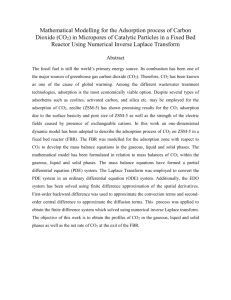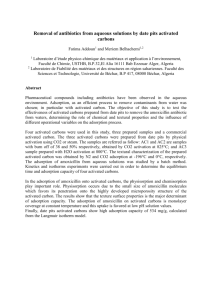Kinetic Studies on Carbon Dioxide Capture using Activated
advertisement
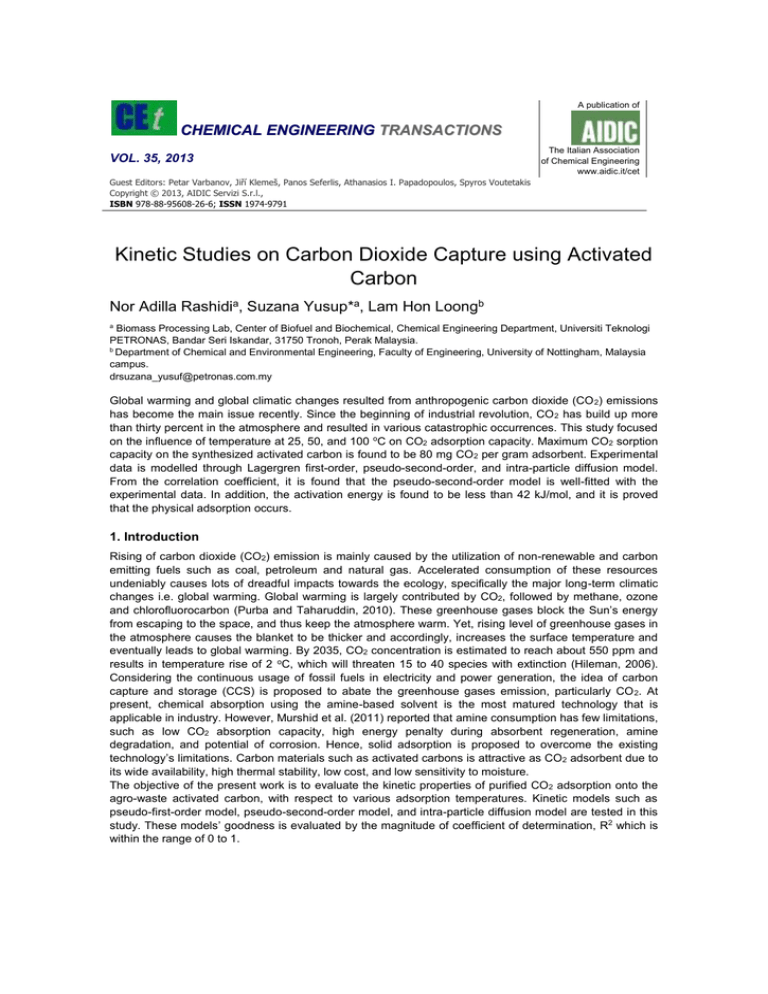
A publication of CHEMICAL ENGINEERING TRANSACTIONS VOL. 35, 2013 The Italian Association of Chemical Engineering www.aidic.it/cet Guest Editors: Petar Varbanov, Jiří Klemeš, Panos Seferlis, Athanasios I. Papadopoulos, Spyros Voutetakis Copyright © 2013, AIDIC Servizi S.r.l., ISBN 978-88-95608-26-6; ISSN 1974-9791 Kinetic Studies on Carbon Dioxide Capture using Activated Carbon Nor Adilla Rashidia, Suzana Yusup*a, Lam Hon Loongb a Biomass Processing Lab, Center of Biofuel and Biochemical, Chemical Engineering Department, Universiti Teknologi PETRONAS, Bandar Seri Iskandar, 31750 Tronoh, Perak Malaysia. b Department of Chemical and Environmental Engineering, Faculty of Engineering, University of Nottingham, Malaysia campus. drsuzana_yusuf@petronas.com.my Global warming and global climatic changes resulted from anthropogenic carbon dioxide (CO 2) emissions has become the main issue recently. Since the beginning of industrial revolution, CO 2 has build up more than thirty percent in the atmosphere and resulted in various catastrophic occurrences. This study focused on the influence of temperature at 25, 50, and 100 oC on CO2 adsorption capacity. Maximum CO2 sorption capacity on the synthesized activated carbon is found to be 80 mg CO 2 per gram adsorbent. Experimental data is modelled through Lagergren first-order, pseudo-second-order, and intra-particle diffusion model. From the correlation coefficient, it is found that the pseudo-second-order model is well-fitted with the experimental data. In addition, the activation energy is found to be less than 42 kJ/mol, and it is proved that the physical adsorption occurs. 1. Introduction Rising of carbon dioxide (CO2) emission is mainly caused by the utilization of non-renewable and carbon emitting fuels such as coal, petroleum and natural gas. Accelerated consumption of these resources undeniably causes lots of dreadful impacts towards the ecology, specifically the major long-term climatic changes i.e. global warming. Global warming is largely contributed by CO2, followed by methane, ozone and chlorofluorocarbon (Purba and Taharuddin, 2010). These greenhouse gases block the Sun’s energy from escaping to the space, and thus keep the atmosphere warm. Yet, rising level of greenhouse gases in the atmosphere causes the blanket to be thicker and accordingly, increases the surface temperature and eventually leads to global warming. By 2035, CO2 concentration is estimated to reach about 550 ppm and results in temperature rise of 2 oC, which will threaten 15 to 40 species with extinction (Hileman, 2006). Considering the continuous usage of fossil fuels in electricity and power generation, the idea of carbon capture and storage (CCS) is proposed to abate the greenhouse gases emission, particularly CO 2. At present, chemical absorption using the amine-based solvent is the most matured technology that is applicable in industry. However, Murshid et al. (2011) reported that amine consumption has few limitations, such as low CO2 absorption capacity, high energy penalty during absorbent regeneration, amine degradation, and potential of corrosion. Hence, solid adsorption is proposed to overcome the existing technology’s limitations. Carbon materials such as activated carbons is attractive as CO2 adsorbent due to its wide availability, high thermal stability, low cost, and low sensitivity to moisture. The objective of the present work is to evaluate the kinetic properties of purified CO2 adsorption onto the agro-waste activated carbon, with respect to various adsorption temperatures. Kinetic models such as pseudo-first-order model, pseudo-second-order model, and intra-particle diffusion model are tested in this study. These models’ goodness is evaluated by the magnitude of coefficient of determination, R2 which is within the range of 0 to 1. 2. Experimental 2.1 Preparation of activated carbon The agro-waste based activated carbon were dried and prepared as described by Rashidi et al. (2012). The activation process under the CO2 flow (99.8% purity) was carried out by using the Taguchi method, with L25 (56) orthogonal array. In this study, six main parameters include the type of precursors, particle size, heating rate, CO2 flow rate, temperature, and holding time were evaluated with five levels each, as shown in Table 1. Table 1: Design factors and levels for activation process Process parameter Precursors Particle size Heating rate CO2 flow rate Temperature Holding time Unit Level 1 Level 2 Level 3 Level 4 Level 5 μm oC/min cm3/min oC min Palm fiber 250 5 100 500 15 Palm shell 355 10 150 600 30 Rice husk 500 15 200 700 45 Coconut shell 710 20 250 800 60 Coconut fiber 1000 25 300 900 90 2.2 Isothermal CO2 adsorption/desorption CO2 adsorption/desorption studies were performed by using a thermal gravimetric analyzer (EXSTAR TG/DTA 6300). The process involved placing samples (5-10 mg) into an alumina pan and the operating temperature was adjusted to adsorption temperature of 25, 50 and100 oC under the purified CO2 (99.98 % purity), at flow rate of 50 cm3/min. Prior to the adsorption process, the sample materials were activated at 120 oC under a vacuum condition overnight, to ensure that an excess moisture had been entirely removed. Once the equilibrium state achieved, desorption process was carried out by switching the gas to pure nitrogen (50 cm3/min) at the same temperature. The exposure time of adsorption and desorption time was 2 h each. For comparison purposes, the commercial activated carbon of size 250 μm was used. The amount of CO2 molecules adsorbed onto the synthesized activated carbon (mg/g) was calculated based on Eq. (1), where wt and wo represents mass of adsorbent at time t and original mass of adsorbent, respectively. CO2 Adsorption wt wo wo (1) 3. Results and discussions 3.1 General characteristics of activated carbon A series of activated carbon were developed according to the orthogonal array determined. In our study, commercial and optimized activated carbons were tested for the kinetic analysis. The optimized activated carbon referred to the coconut shell of size 250 μm, and at operating condition of 900 oC with 20 oC/min heating rate, and at 45 min holding time under the 150 mL CO2 flow, which had the utmost CO2 adsorption capacity, around 79 mg/g. In contrast, the commercial activated carbon had an adsorption capacity of 81 mg/g. The chemical compositions of the raw precursors, optimized and commercial activated carbon were summarized in Table 2. Table 2: Chemical compositions of the precursors (coconut shell), optimized and commercial activated carbon Parameters Raw coconut shells Elemental analysis (wt %): Carbon 50.08 Hydrogen 6.08 Nitrogen 0.05 Sulphur 0.62 Oxygen 43.25 Moisture content (wt %) 1.91 Optimized activated carbon Commercial activated carbon 88.18 1.32 0.40 0.25 9.87 1.43 72.38 2.10 0.20 0.27 25.05 2.21 According to Table 2, both raw material and activated carbons that have moisture content less than the recommended value (less than 3 %) is very significant and ideal for storage purposes. The significance of having lower moisture content in solid sorbent is due to the potential of fungi growth and multiplication, which will result in carbon degradation and pore blockage (Hapazari et al., 2011). Upon activation process, the heat treatment of the precursors causes reduction of moisture and volatiles matters, while enhancing the carbon content. In addition, surface morphology of the carbonaceous materials were studied, and it is evidently shown that the precursor has a rough surface, porous-less and without any cracks or cavities. On the other hand, the produced activated carbon has some cavities and hollows, which was attributed by the devolatilization of inorganic materials that were initially attached to the carbon wall. a b Figure 1: FESEM image of (a) raw coconut shell, and (b) coconut-shell activated carbon. 3.2 CO2 adsorption/desorption Figure 2 illustrates the adsorption profiles at different reaction temperatures of both the commercial and optimized activated carbon. Based on Figure 2, it shows that the rate of CO2 adsorption gradually decreased with contact time, until an equilibrium condition was achieved. The CO2 adsorption was most intensive during the first 40 min, and thereafter remains unchanged until saturation was attained. The rapid adsorption rate could be attributed to the sorbent surface area which is accountable for interaction with the CO2 molecules. Over time, the adsorption rate is observed to be decreased due to reduction of active sites that may slow down the adsorption process from taking place. In addition, Li et al. (2008) suggest that the rapid adsorption at the beginning of the process is due to external surface of the adsorbent, and is followed by slower internal diffusion process. CO2 adsorption capacity (mg/g) 90 80 70 60 50 40 30 20 10 0 0 20 40 60 Time (min) 80 100 OAC_25 degC OAC_50 degC OAC_100 degC CAC_25 degC CAC_50 degC CAC_100 degC 120 Figure 2: Adsorption profiles of commercial and optimized activated carbon at 25, 50 and 100 oC (OAC = Optimized activated carbon; CAC = Commercial activated carbon) In post-combustion processes, the flue gas temperature is typically within the range of 50 to 120oC (Kaithwas et al., 2012). Thus, an adsorption study was conducted at 50 and 100 oC to investigate the CO2 adsorptive properties at an elevated temperature. Figure 2 and Table 3 show that the CO2 adsorption capacity of both solid adsorbents decreases with temperature, and it implies the existence of physical adsorption (physisorption) between the CO2 molecules and carbonaceous adsorbent. Maroto-Valer et al. (2005) reported that physisorption process involves high surface adsorption energy and molecule diffusion at elevated temperatures, which results in instability of the adsorbed gas on the surface of activated carbon and consequently, desorption process will occur. In our study, almost complete CO2 regeneration was observed during the desorption process (shown in Table 3), and it indicates the presence of weaker interaction bonding between the adsorbate and adsorbent. It is supported by Shafeeyan et al. (2011) who reported that the chemisorption between the CO2 molecules and modified activated carbon results in the lowest desorption capacity (91.9 wt%), despite of its highest CO2 adsorption capacity. This is due to strong affinity of CO2 and solid adsorbent that hinder the regeneration/desorption process. In contrast, weaker bonding between the CO2 molecules and activated carbon lead to the highest desorption capacity, around 99.4 wt%. In practical, adsorption and desorption capacity must be balanced to achieve the technoeconomic feasibility. Table 3: CO2 adsorption-desorption behaviour on the activated carbon Adsorbent Optimized activated carbon Commercial activated carbon Temperature (oC) CO2 uptake (wt%) 25 50 100 25 50 100 7.88 5.58 1.89 8.11 5.70 2.19 Desorption (wt%) 98.70 99.13 100.00 100.00 100.00 100.00 capacity 3.3 Kinetic analysis The kinetic analysis establishes an adsorption uptake rate and determines the residence time for the adsorption process to be completed. It is also a baseline on determining the adsorption dynamics and its performance in real application, such as in fixed-bed or in flow-through systems. Thus, Lagergren pseudofirst-order model and pseudo-second-order model was performed in this work. The conformity of the experimental work and kinetic model was analyzed by the regression coefficient values (0<R2<1). The linearized Lagergren pseudo-first-order is generally expressed by Eq. (2) (Ho and McKay, 1998). log q e q t log q e k1 t 2.303 (2) Based on Eq. (2), qe and qt are the adsorption capacity (mg/g) at equilibrium and at time t, respectively and k1 is the rate constant of pseudo-first-order model (1/min). The straight line plot of log (qe-qt) versus time (t) was made at various adsorption temperatures for both of the activated carbons, and the parameters were tabulated in Table 4. It was observed that the pseudo-first-order kinetic model did not fit well with the experimental data, with R2 value was found to be within the range of 0.89 to 0.98. Table 4: Kinetic parameters of the activated carbons (OAC = Optimized activated carbon; CAC = Commercial activated carbon) Kinetic model Pseudofirst-order Pseudosecondorder Parameter k1 (1/ min) qe (mg/g) R2 qe (mg/g) k2 (g/mg∙min) h (mg/g∙min) R2 Temperature (oC) 25 OAC CAC 0.039 0.042 55.463 45.709 0.984 0.987 86.207 86.957 50 OAC 0.032 43.471 0.986 63.694 CAC 0.049 32.300 0.990 60.606 100 OAC 0.020 7.903 0.887 20.120 CAC 0.018 7.147 0.728 22.989 1.076E-3 1.370E-3 8.844E-4 2.482E-3 4.002E-3 4.450E-3 7.994 1.000 10.363 0.999 3.588 1.000 9.116 0.999 1.620 0.996 2.352 0.995 In addition, pseudo-second-order model and initial rate of adsorption, h (mg/g∙min) is expressed by Eq. (3) and Eq. (4), respectively (Ho and McKay, 1998). t 1 1 t 2 qt k 2 qe qe (3) h k 2 qe (4) 2 Similar as the Lagergren pseudo-first-order model, qe and qt represents the amount of adsorbate adsorbed per unit mass of adsorbent at equilibrium and at any time (t). If the pseudo-second-order kinetic model is applicable in the adsorption process, plot of t/qt against time will result in a straight line with 1/h and 1/qe is the y-intercept and slope, respectively. Comparing the value of regression coefficient as stated in Table 4, pseudo-second-order model gives better fit than the Lagergren first-order model. In addition, the initial adsorption rate (h) was observed to decrease with respect to temperature. It is explained by higher kinetic energy of the CO2 adsorbate at elevated temperatures, which resulted in its increasing tendency to escape from the surface of activated carbon. In contrast to Lagergren pseudo-first-order and pseudo-second-order model, intra-particle diffusion model provides an insight of the mechanism in adsorption process. Adsorption consists of few steps involve the transport of adsorbate from the bulk phase to the surface of solid sorbent, and is followed by the molecules diffusion into the interior of the pores. Intra-particle diffusion normally is described as a slow process and is a rate-limiting step in many of adsorption processes, and it can be expressed by Eq. (5) below. q t k id t 1 / 2 C i (5) qt (mg/g) According to Eq. (5), qt represents the percentage of CO2 adsorbed onto the activated carbon (%), kid is the intra-particle rate constant (mg/min∙t1/2), and t is the contact time (min1/2). Plot of qt against the square root of t is illustrated in Figure 3. Theoretically, if the adsorption process obeys the intra-particle diffusion model, a straight linear plot that passes through the origin is expected. However, Figure 3 shows variation of gradient with respect to time and it indicates that the intra-particle diffusion is not the sole rate-limiting step in this adsorption process. The first steeper region (4-7 min1/2) could be due to surface sorption, whilst the second region (7-11 min1/2 ) may be attributed by the intra-particle diffusion rate-controlled. 90 80 70 60 50 40 30 20 10 0 2 4 6 8 Time 10 12 (min1/2) OAC_25 degC CAC_25 degC OAC_50 degC CAC_50 degC OAC_100 degC CAC_100 degC Figure 3: Intra-particle diffusion study (OAC = Optimized activated carbon; CAC = Commercial activated carbon) The magnitude of the activation energy (Ea) is important in any of adsorption process, as it provides insight information on the mechanism of the adsorption process. Since the physical adsorption involves weak bonding between the adsorbate and adsorbent, the value of activation energy is usually around 5 to 40 kJ/mol, whilst the chemisorption process has activation energy of 40 to 800 kJ/mol (Özcan et al., 2006). To calculate the activation energy of the adsorption process, the Arrhenius equation that is shown in Eq, (6) is applied (Özcan et al., 2006). ln k Ea ln k o RT (6) In Eq. (6), k is the rate constant of pseudo-second-order kinetic model (g/mg∙min), Ea is the adsorption activation energy (J/mol), R is the gas constant (8.314 J/mol∙K), T is the adsorption temperature in Kelvin, and ko is the temperature independent factor (g/mg∙min). This study shows that the activation energy for optimized and commercial activated carbon is 17.51 and 14.27 kJ/mol, respectively. In addition, lower activation energy found in this work implies that the CO2 adsorption onto the activated carbons is a diffusion-controlled process, rather than the chemically-controlled. 4. Conclusions The equilibrium and kinetic of CO2 adsorption onto the activated carbon has been studied in the present work. The decreased in CO2 adsorption capacity with an increased in temperature suggested that the adsorption process is exothermic in nature. In addition, the value of activated energy which is about 17 J/mol proves the occurrence of physisorption process. Besides, the adsorption kinetic is analyzed by the Lagergren pseudo-first-order model, pseudo-second-order model and intra-particle diffusion model, and finding shows that the CO2 adsorption is best described with pseudo-second-order model. The present study concludes that the agro-waste based activated carbon is a promising adsorbent to be utislized for CO2 capture. References Hapazari I., Ntuli V., Parawira W., 2011, Evaluation of single-step steam pyrolysis-activated carbons from lesotho agro-forestry residues, Tanzania Journal of Science, 37, 120-128. Hileman B., 2006, Climate change threatens global economy, Chemical & Engineering News, 84, 7–8. Ho Y.S., McKay G., 1998, A comparison of chemisorption kinetic models applied to pollutant removal on various sorbents, Process Safety and Environmental Protection, 76, 332-340. Kaithwas A., Prasad M., Kulshreshtha A., Verma S., 2012, Industrial wastes derived solid adsorbents for CO2 capture: A mini review, Chemical Engineering Research and Design, 90, 1632-1641. Li W., Zhang L., Peng J., Li N., Zhang S., Guo S., 2008, Tobacco stems as a low cost adsorbent for the removal of Pb(II) from wastewater: Equilibrium and kinetic studies, Industrial Crops and Products, 28, 294-302. Maroto-Valer M.M., Tang Z., Zhang Y., 2005, CO2 capture by activated and impregnated anthracites, Fuel Processing Technology, 86, 1487-1502. Murshid G., Shariff A.M., Keong L.K., Bustam A.M., 2011, Thermo physical analysis of 2-amino-2-methyl1-propanol solvent for carbon dioxide removal, Chemical Engineering Transactions, 25, 45-50, DOI: 10.3303/CET1125008. Özcan A., Öncü E.M., Özcan A.S., 2006, Kinetics, isotherm and thermodynamic studies of adsorption of acid blue 193 from aqueous solutions onto natural sepiolite, Colloids and Surfaces A: Physicochemical and Engineering Aspects, 277, 90-97. Purba E., Taharuddin T., 2010, CO2 reduction and production of algal oil using microalgae nannochloropsis oculata and tetraselmis chuii, Chemical Engineering Transactions, 21, 397-402, DOI: 10.3303/CET1021067. Rashidi N.A., Yusup S., Ahmad M.M., Mohamed N.M., Hameed B.H., 2012, Activated carbon from the renewable agricultural residues using single step physical activation: A preliminary analysis, APCBEE Procedia, 3, 84-92. Shafeeyan M.S., Daud W.M.A.W., Houshmand A., Arami-Niya A., 2011, Statistical modelling and optimization of amination conditions of activated carbon for carbon dioxide adsorption using response surface methodology, Proceedings of 3rd International Conference on Chemical, Biological and Environmental Engineering (ICBEE 2011), 20, 13-18, Singapore, 16-18 September 2011.

